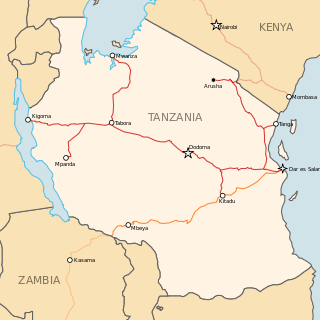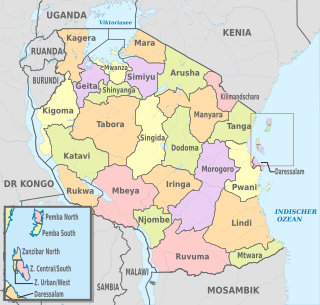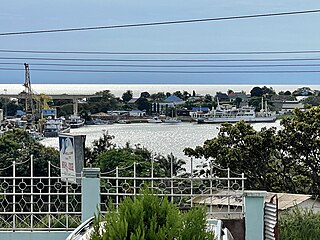Related Research Articles
Transport in Tanzania includes road, rail, air and maritime networks. The road network is 86,472 kilometres (53,731 mi) long, of which 12,786 kilometres (7,945 mi) is classified as trunk road and 21,105 kilometres (13,114 mi) as regional road. The rail network consists of 3,682 kilometres (2,288 mi) of track. Commuter rail service is in Dar es Salaam only. There are 28 airports, with Julius Nyerere International being the largest and the busiest. Ferries connect Mainland Tanzania with the islands of Zanzibar. Several other ferries are active on the countries' rivers and lakes.

Dodoma, officially Dodoma City, is the capital of Tanzania and the administrative capital of both Dodoma Municipal Council and the entire Dodoma Region, with a population of 765,179. In 1974, the Tanzanian government announced that Tanzania's federal capital would be moved from Dar es Salaam to Dodoma for social and economic reasons and to centralise the capital within the country. It became the official capital in 1996.

Following Tanganyika's independence (1961) and unification with Zanzibar (1964), leading to the formation of the state of Tanzania, President Julius Nyerere emphasised a need to construct a national identity for the citizens of the new country. To achieve this, Nyerere provided what has been regarded by some commentators as one of the most successful cases of ethnic repression and identity transformation in Africa.

The Catholic Church in Tanzania is part of the worldwide Catholic Church, under the spiritual leadership of the Pope in Rome.
Radio Tanzania Dar es Salaam is a radio service in Tanzania.

The following outline is provided as an overview of and topical guide to Tanzania:

Railway stations in Tanzania include:

The administrative divisions of Tanzania are controlled by Part I, Article 2.2 of the Constitution of Tanzania. Tanzania is divided into thirty-one regions. Each region is subdivided into districts. The districts are sub-divided into divisions and further into local wards. Wards are further subdivided for management purposes: for urban wards into streets and for rural wards into villages. The villages may be further subdivided into hamlets.
The Tanzanian Championship is the second tier of league football in Tanzania. The league is made up of sixteen teams that play thirty rounds, home and away.The league was formed in 1930.
The First League Tanzania is the third tier of league football in Tanzania. The league is divided into two groups, with each group having eight teams. A round-robin format is played and followed by a play-off tournament for promotion and relegation.

Mass media in Tanzania includes print, radio, television, and the Internet. The "Tanzania Communications Regulatory Act" of 2003 created the Tanzania Communications Regulatory Authority, which oversees broadcast licensing. The Media Council of Tanzania began in 1995.

National Historic Sites of Tanzania is an official list of places in Tanzania that have been designated as National Historic Sites as per the Ministry of Natural Resources and Tourism of Tanzania under the Antiquities Division. The list is not complete and is currently being updated.

Kasingirima is an administrative ward in Kigoma-Ujiji District of Kigoma Region in Tanzania. The ward covers an area of 0.2 km2 (0.077 sq mi), and has an average elevation of 799 m (2,621 ft). In 2016 the Tanzania National Bureau of Statistics report there were 3,156 people in the ward, from 2,867 in 2012.

Kigoma is an administrative ward in Kigoma-Ujiji District of Kigoma Region in Tanzania. The ward covers an area of 4 km2 (1.5 sq mi), and has an average elevation of 789 m (2,589 ft). In 2016 the Tanzania National Bureau of Statistics report there were 7,604 people in the ward, from 6,908 in 2012.

Rusimbi is an administrative ward in Kigoma-Ujiji District of Kigoma Region in Tanzania. The ward covers an area of 0.7 km2 (0.27 sq mi), and has an average elevation of 783 m (2,569 ft). In 2016 the Tanzania National Bureau of Statistics report there were 7,462 people in the ward, from 6,779 in 2012.
Businde is an administrative ward in Kigoma-Ujiji District of Kigoma Region in Tanzania. The ward covers an area of 7.8 km2 (3.0 sq mi), and has an average elevation of 808 m (2,651 ft). In 2016 the Tanzania National Bureau of Statistics report there were 2,681 people in the ward, from 2,436 in 2012.
Independent Television is a commercial television network in Tanzania owned by IPP Media.
References
- ↑ "MEDIA PROFILE - TANZANIA" (PDF). Gamos Ltd. 2003. Archived (PDF) from the original on 20 June 2022. Retrieved 5 November 2023.
- ↑ "Tanzania's top dogs open 2nd channels", Africa Film & TV Magazine, nº. 26, August-October 2000
- ↑ "Tanzania: Fake News Increasingly Haunts Tanzania". The CItizen. Dar Es Salaam: AllAfrica. 12 March 2017. Retrieved 23 August 2017.
- ↑ Nkwame, Marc (28 July 2013), "Tanzania: Digital Beats Analogue in More Television Coverage", AllAfrica, retrieved 23 August 2017
- ↑ "Tanzania profile - Media1", BBC, 8 August 2017, retrieved 23 August 2017
- ↑ "HOME", Tanzania Broadcasting Corporation, archived from the original on 24 June 2022, retrieved 23 August 2017